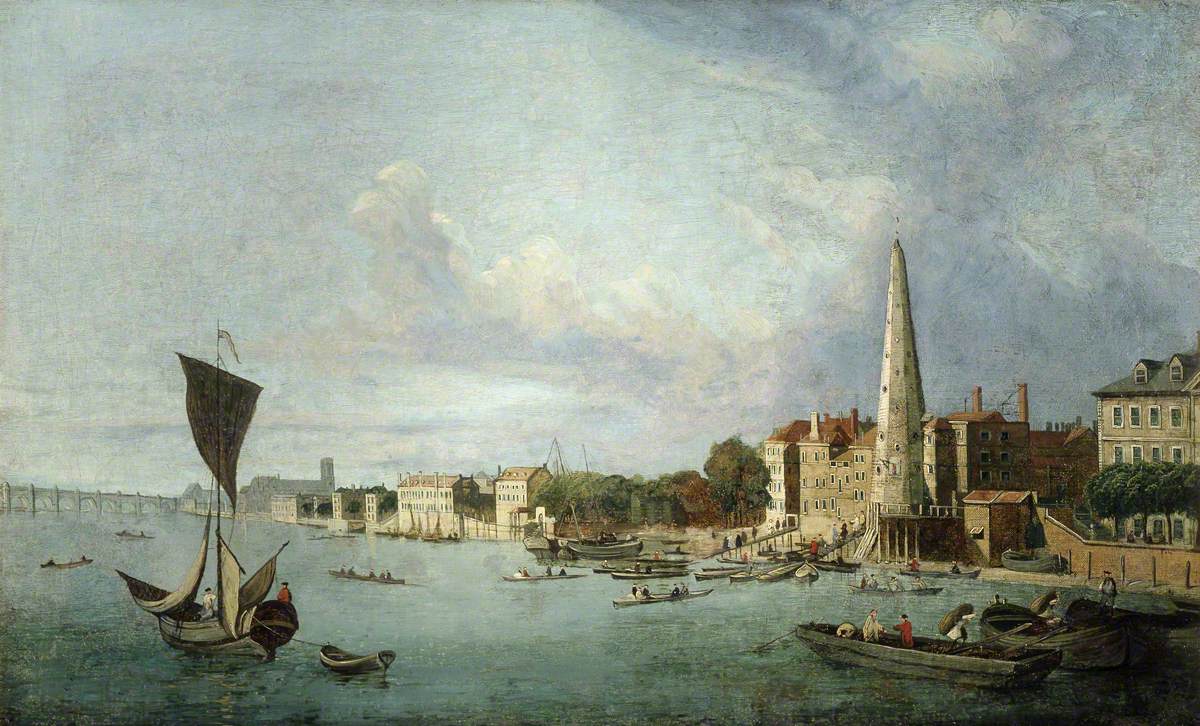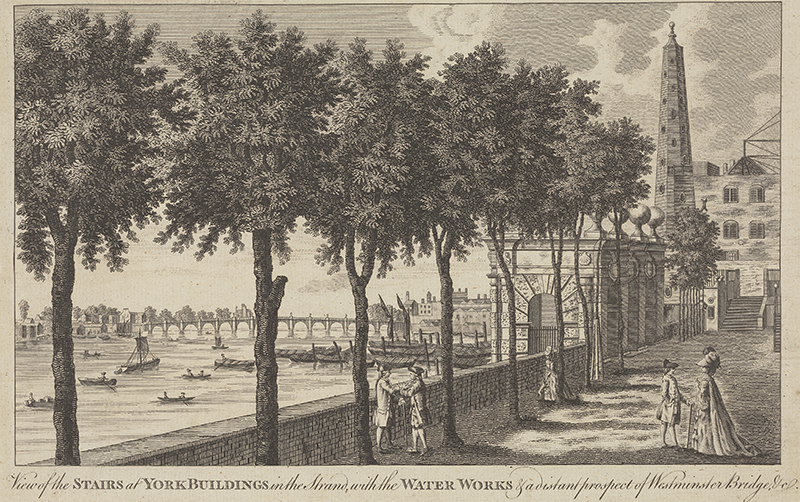The York Buildings Company
Pat Rogers, University of South Florida
August 2023
The undertaking went from an innovative method of supplying piped water to the citizens of London to a snapper-up of forfeited estates and a disreputable Bubble company. It was originally founded in 1675, when two speculators obtained a royal licence for ninety-nine years to erect a plant on the banks of the Thames to channel water to adjoining parts of the capital, many of whIch had previously been dependent on springs and polluted drains. The works were burnt to the ground in 1690 and then replaced by new equipment. A fresh charter of incorporation was granted in 1691, in accordance with which the Company went on in its respectable way for more than a quarter of a century. It charged an average of twenty-five shillings (£1.25) a year to supply householders, mainly in what is now called the West End of London.
The method used to transport the water was quite simple. It was led from the river at York Buildings “into canals with sluices, and thence pumped up by horse to cisterns on the higher ground, from which it was conveyed to the customers’ houses by service pipes connected with two 7-inch elmwood mains laid through the street” ((David Murray). As indicated, the pumping mechanism was based on the use of horse traction, but two experiments were made with water-raising steam pumps. The first trial involved a device patented in 1698 by Thomas Savery (1650?–1715), mainly intended for draining mines. This proved unsatisfactory and failed to use energy in a sufficiently economical way. It was replaced in 1726 by a much-improved version involving a piston produced by Savory’s former associate, Thomas Newcomen (1664–1729), the most important pioneer of steam engines in Britain, whose design remained a standard until the work of James Watt in 1770. The most visible feature of the works was an octagonal wooden tower alongside the engine shed, about seventy feet tall, which shows up in many views of the riverside in this period, including those of Canaletto. It survived until the creation of the Embankment. This new pump also proved too expensive to run, and from about 1731 horse power was again required at a far from negligible cost of £600 per annum—although the mechanism was preserved as an object of interest.
The Company took its name from the buildings erected on the site of a medieval mansion demolished in the 1670s. Its works stood at the southern end of Villiers Steet, which ran from the Strand towards the river, and now adjoins Charing Cross railway station, separated from the Thames by the Victoria Embankment, which was created from 1864 to 1870 on reclaimed land.
In 1719, the whole identity of the Company underwent a change that was both dramatic and curious. The key figure in this turn-around was Case Billingsley (b. 1676?), perhaps the most notorious of all the company promoters in the era of the South Sea Bubble. Variously described as a merchant and a solicitor, he might more frankly categorised as a speculator, a stockjobber, a forger, a crook, and a bolter. He had been one of the many who attempted to devise a scheme for finding the longitude at sea: later on, he took out a patent lasting fourteen years for an engine to raise water, another of the obsessive quests of inventors at this date. His outlook is clear from the testimony he gave to a committee of the House of Commons, where he cheerfully admitted that in 1718 he had offered the government’s two chief law officers one thousand guineas each, if the charter for his marine insurance company was granted—he did not regard this as a bribe. Eventually the insurance scheme went ahead. In 1722 Billingsley launched the Harburgh Company, with the Prince of Wales as governor, in which the former Attorney-General, Nicholas Lechmere, took part. It turned out to be a spectacular fraud that brought down some big names in the financial world. The suggestion was made during investigations that Billingsley had tampered with, or even forged, the supposed sign manual under the king’s hand that set up the Company. Conveniently he failed to show up for interrogation. Newspaper reports described how “the Knaves of Projectors had Projected about 200,000l. into their own Pockets in Form of a Lottery.” It was further rumoured, at least, that “Mr. Case Billingsley, one of the chief Contrivers of the Fraudulent Harburgh Lottery, being arrived in Holland retired soon after to remoter Parts.” Somehow he was able to undergo rehabilitation and return to his former life in London.
This was the man who in October 1719 had led a syndicate to buy the York Buildings Company for just over £7,000, estimated as four years’ purchase of the annual earnings. His motives lay in an unnoticed clause in the 1691 charter, that allowed the firm to “purchase and alien lands and hereditaments” (that is, to transfer assets by purchase or sale). The timing was right, because there was a glut of property on the market, of which the government wished to dispose. This came about because of the Crown Lands Act, passed after the defeat of the Rising in 1715/16 to punish Jacobite rebels, some of whom were large landholders, especially in Scotland. The Commissioners appointed by this measure were making slow progress in liquidating these states, and so the ever-observant Billingsley stepped in. As the speculative mania increased on the back of South Sea gains, the York Buildings Company was able to raise over £1,000,000 in stock, from which it allocated £300,000 to the acquisition of forfeited estates, bringing in an estimated £15,000 annually in rents. In March 1720 they decided to lease the properties to middlemen, an obvious convenience since they lay several hundred miles away and it took at least a week to reach them from London.
At this stage the signs were all good. Boosted by his success, Billingsley had resolved to add to the company’s portfolio a stake in the burgeoning (but far from secure) insurance market. The price of shares rocketed up from £90 in mid-June 1720 to almost £300 in August. In this it mirrored the fortunes of the South Sea Company. Alarmed by the speculative frenzy, the government sought to limit the growth of bubble companies. As a result, the York Buildings enterprise found its room for manoeuvre considerably diminished, and a sudden outflow of stock followed. As with the great behemoth that had caused the Bubble, Company shares became almost unsaleable by the end of September. In the months to come, the price hovered between 55 and 15. As a remedy, Billingsley drew on his background as a gambler to propose a lottery, selling annuities on single lives. Despite his shady past, Billingsley was allowed to set up three lotteries with official sanction, held between December 1721 and November 1723. Many complaints were made about irregularities on the draws and subsequent investigation revealed corrupt practices of the sort that plagued all Billingsley’s activities.
This plan did not work either. However, the Company struggled on, endeavouring to recoup its losses by exploiting its mineral rights in Scotland. Among those active in this undertaking was the writer and projector Aaron Hill (1685–1750), who superintended a scheme to provide timber for shipbuilding from a site near Abernethy on Speyside. The enterprise proved a failure once more and was discontinued in 1730.
What of the original business at York Buildings, which was in danger of becoming a shell company for unrelated activities? Yet another abortive plan was initiated in the mid 1720s. The key figure was the Duke of Chandos (1674–1744), a grandee whose investment interests straddled every kind of business, large or small, safe or risky, domestic or international. A number of sources list Chandos as governor of the Company in 1719, but though he put money into its coffers there is no confirmation of this appointment. In 1725 he was developing the area around Cavendish Square acquired from the Earl of Oxford, then engaged in the creation of the Portland estate north of Oxford Street, which did so much to fashion this part of London as the capital spread out into formerly rustic Marylebone. As part of his scheme, Chandos set about constructing a reservoir to contain 100,000 tons of water on the northern edge of his ground, situated north of Queen Anne Street and on the line of present-day Mansfield Street. It was to be about 1,400 feet by 60. The idea was to provide a funnel as high as the York Buildings to carry water direct from the Thames-side plant to the reservoir, which came to be known as the Marylebone Basin. The Company agreed in May 1725 to take a lease of 99 years at £155 per annum, with an option to purchase subsequently. This deal was conditional on an offer by the Duke to buy 10,000 additional shares. Excavation began in July, with 300 workers employed, paid by Chandos, and completed by April 1726. However, the Company never paid any rent, and the reservoir lay idle for the rest of the owner’s lifetime, meaning that planned residential building alongside would not take place. In 1749 his son and successor sold the northern strip of land back to the Harley family for £250. The basin was filled in during the 1760s and built over by Robert Adam among others.
Various other projects were contemplated by the Company and by Chandos himself. One involved building another reservoir at St. James’s Square in Westminster, which survived from 1727 to around 1808. The Duke’s technical advisor was the renowned Huguenot engineer and populariser of Newtonian physics, John Theophilus Desaguliers, FRS (1683–1744). A contemporary satire on some of these undertakings, entitled The York Buildings Dragons was published in December 1723, with a second edition. The pamphlet continues to be attributed to Deasguliers, but this is wholly implausible. Even if the scientist had wished to poke fun at the Company, and had possessed the wit, verbal ingenuity and taste for plain speaking that the work exhibits (he was after all a clergyman), one fact invalidates the suggestion—he is the subject of oblique and good natured amusement in the text. The true author was almost certainly John Arbuthnot (1667–1735), the most prolific satirist at this juncture. He knew most of the principals in this story, including Desaguliers, a colleague in the Royal Society, and someone he met often among the Handel circle who gathered at Cannons, the palatial home of Chandos outside London. The pamphlet takes shots at a wide range of targets in the world of science, including hydraulic engineering.
The Company carried on in its seamy fashion. In the early 1730s it became involved with the Charitable Corporation, itself the subject of a notorious scandal relating to widespread fraud, and one of its renegade directors, George Robinson, a stockbroker and MP. The untrustworthy governor, Colonel Samuel Horsey (d.1738), was ejected in 1733, and ended up in gaol after losing a suit brought by the Company claiming moneys owed. As time went on, more and more of the estates had to be sold to pay off debts. The waterworks were leased to others and finally sold in 1818 to the New River Company, its longtime, and ultimately more successful, rival. The York Buildings enterprise was wound up by Parliament in 1829, long after it served any obvious purpose. As David Murray remarked, “It had commenced life very modestly, and it expired unnoticed and without regret.”
The most detailed history remains David Murray, The York Buildings Company: A Chapter Scottish History (183, reprinted Edinburgh,1883).
 Westminster and the York Buildings Waterworks, ca. 1750. Parliamentary Art Collection WOA 2931. This image can be used for non-commercial research or private study purposes in the UK. In certain other jurisdictions it is considered to be in the public domain. |
